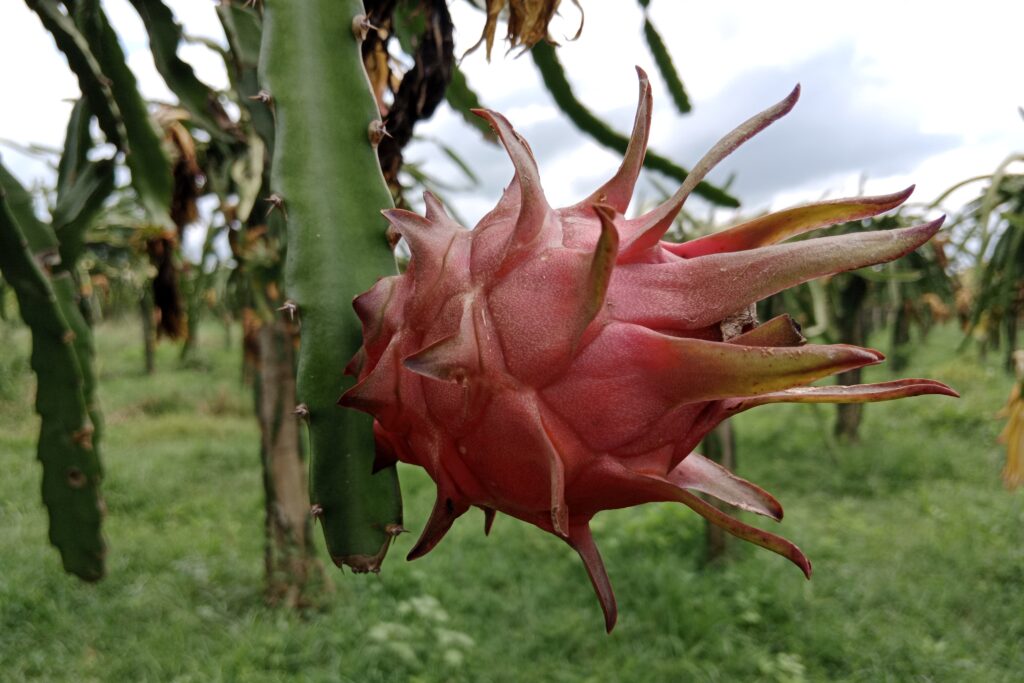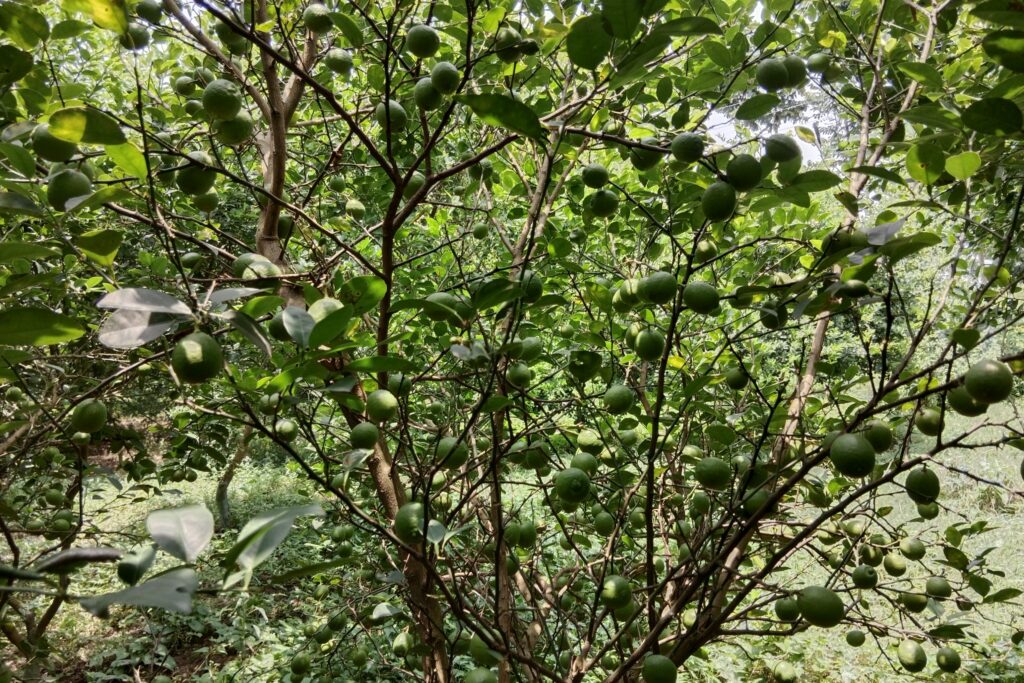Squash Farming
The Cucurbitaceae family includes the versatile and nutrient-dense squash, which is grown extensively for its delicious seeds and soft fruits. Due to its great yield potential and ability to adapt to a variety of climates, squash is a crop that is valued in both home gardens and commercial farming. Vegetable growers looking for both profitability and nutritional value frequently choose it because, with the right management, it yields substantial financial benefits.
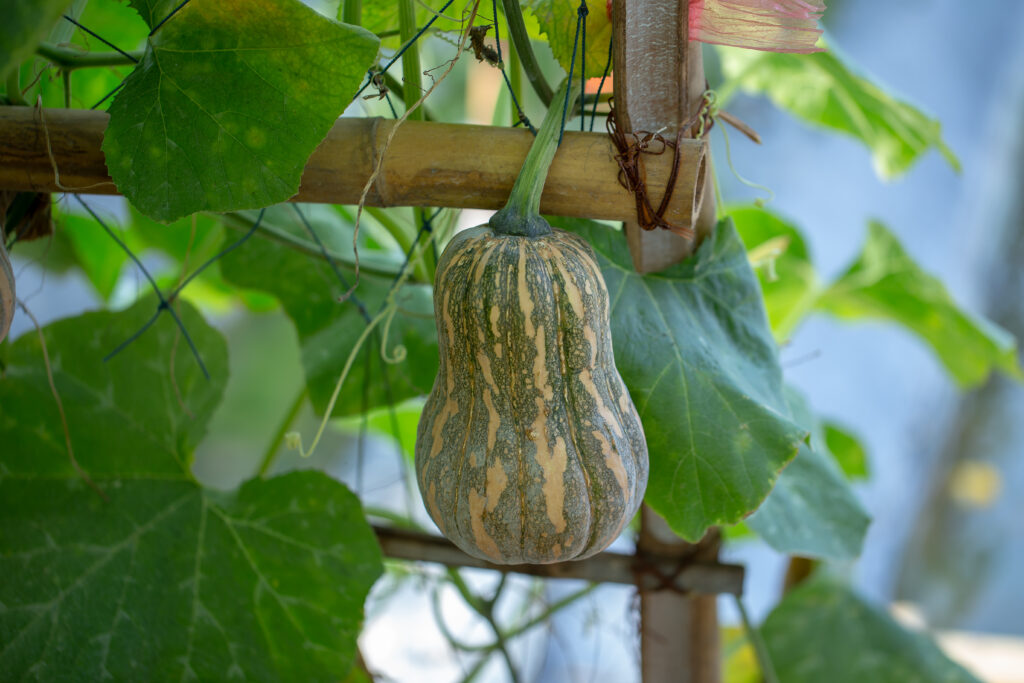
Squash farming can be a highly profitable venture, and understanding the financial returns is essential for planning. Squash farming profit per acre can be calculated by subtracting the total investment cost from the total income, which in this example yields NRs. 219,000 from a total income of NRs. 275,000 and an investment of NRs. 56,000.
The efficiency of this investment can be measured through the return on investment (ROI), calculated as (Net Profit ÷ Total Investment Cost) × 100, resulting in an impressive ROI of approximately 391%, highlighting the lucrative potential of squash cultivation.
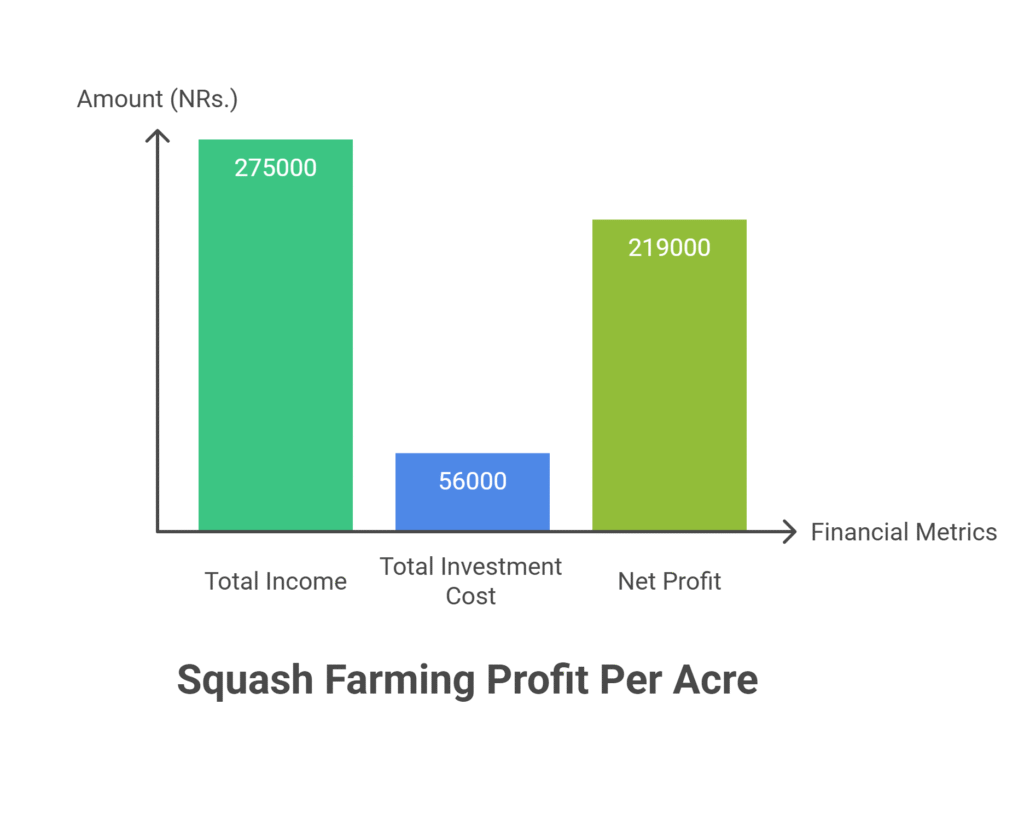
Land Preparation
Proper land preparation is essential for ensuring healthy root development and effective water drainage. The process begins with a deep plowing or digging to a depth of 30–40 cm to break up hardpans and allow roots to penetrate deeply. After the initial plowing, the soil should be left to weather for a week before carrying out 2–3 cross harrowings to break down large clods and achieve a fine, smooth, and level seedbed.
During the final harrowing, well-decomposed Farm Yard Manure (FYM) or compost should be incorporated evenly into the soil to improve fertility and structure. Finally, raised beds or ridges and furrows should be formed, particularly in areas with heavy rainfall or poor drainage, to prevent waterlogging and protect plant roots.
Soil Type
Squash grows best in well-drained sandy loam or loamy soils enriched with organic matter, as these conditions support healthy root growth and nutrient uptake. The ideal soil pH for optimal growth ranges from 6.0 to 7.0, although the crop can tolerate a slightly broader range, provided the soil is not highly acidic. Good drainage is crucial, since waterlogged conditions can cause root rot and other diseases that severely affect plant health and yield.
Climatic Requirements
A warm season crop that grows best in temperatures between 18°C to 30°C, squash is extremely vulnerable to frost, and seed germination is most effective when soil temperatures are higher than 15.5°C. To promote good development, flowering, and fruiting, it needs full sun, ideally 6 to 8 hours per day. Excessive rain or high humidity during the flowering stage might harm pollination and raise the danger of fungal infections, even when moderate rainfall is good.
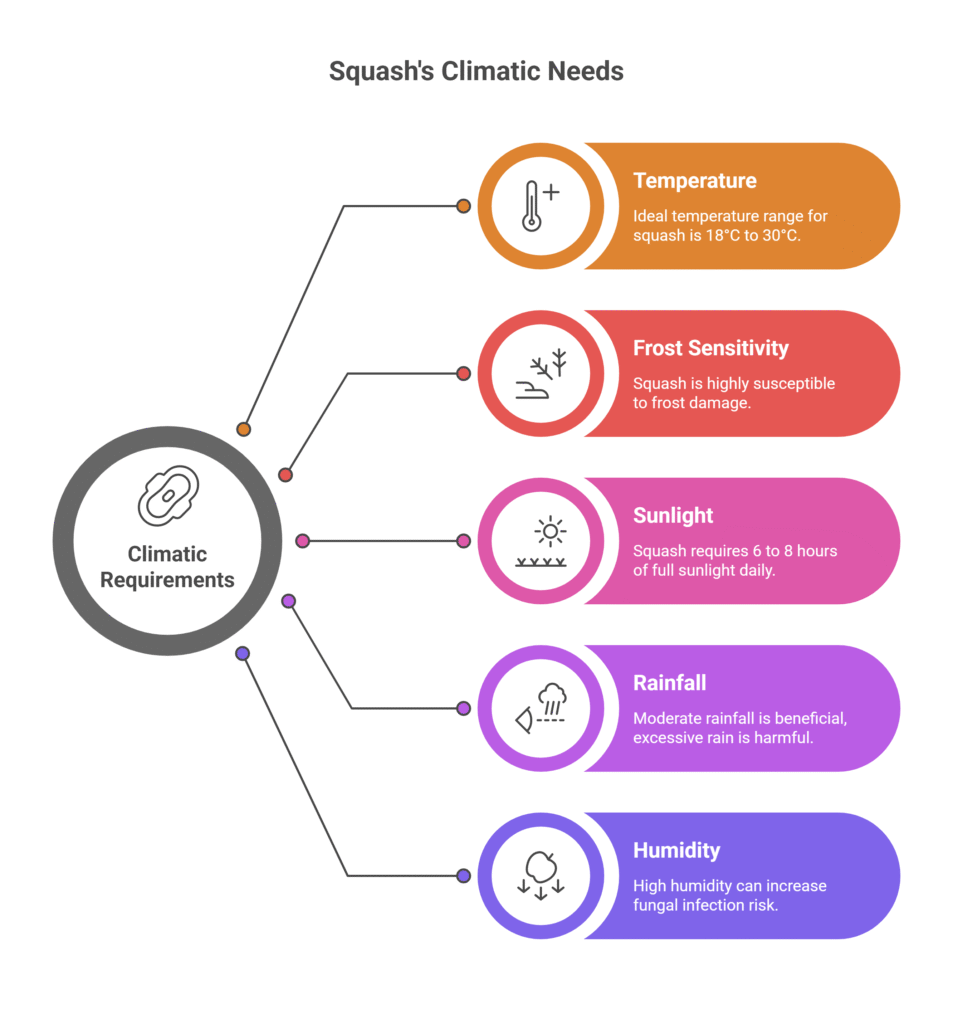
Major Cultivars
Squash cultivars are generally divided into two main categories: summer squash and winter squash. The classification depends on the stage at which they are harvested and consumed, as well as the texture of their skin.
Summer squash varieties are harvested when immature and have tender, edible skin. Some of the popular cultivars include ‘Early Prolific Straightneck’, which produces yellow fruits, ‘Cocozelle’, known for its striped appearance, and ‘Black Beauty’, a well-known zucchini variety.
Winter squash, on the other hand, is harvested at maturity and features a hard rind that allows for longer storage. Common cultivars in this group include Butternut, Acorn, Hubbard, and Spaghetti Squash, each valued for its unique flavor, texture, and culinary use.
In addition to traditional varieties, a wide range of F1 hybrids is available in the market. These hybrids are often high-yielding, disease-resistant, and specifically bred for improved performance. Seed companies such as Syngenta, Nunhems, and Seminis provide many hybrid options, and local agricultural extension offices can offer guidance on the most suitable cultivars for specific growing regions.
Propagation
Squash is almost exclusively propagated by seeds. Using seeds from healthy, disease-free fruits is paramount.
Seed Rate per Acre
The seed rate for squash varies depending on the cultivar, plant spacing, and germination rate, generally requiring about 1.5 to 2.5 kg of seed per acre. For costly hybrid varieties, a lower seed rate of 1.0 to 1.5 kg per acre is often sufficient when using precision planting techniques. To ensure healthy crop establishment, it is essential to use treated seeds, which help protect against soil-borne diseases.
Nursery Management
Although direct seeding is common in squash cultivation, raising seedlings in pro-trays is considered a superior method as it ensures a uniform stand, saves seeds—particularly valuable hybrids—and allows for earlier crop establishment.
For this method, a sterile, well-draining potting mix is used, with one seed sown per cell in 98-cell trays. The nursery should be maintained in a protected environment, such as a greenhouse or under a shade net, with consistent moisture to support healthy growth. Seedlings are typically ready for transplanting within 3–4 weeks, once they develop 2–3 true leaves.
Planting
a). Planting Season
In the plains, squash is mainly planted during February–March in the spring season, with a second crop possible in June–July during the monsoon, while in hilly regions, the ideal sowing period extends from March to May.
b). Spacing
| Squash Type | Row Spacing (cm) | Plant Spacing (cm) | Remarks |
| Bush Types | 90 | 60 | Suitable for compact growth; easier management. |
| Vining Types | 120 | 90 | Wider spacing ensures better air circulation and easier harvesting. |
c). Pit Preparation
For direct seeding or transplanting, dig pits of 30 cm x 30 cm x 30 cm. Mix the topsoil with 5-10 kg of well-rotted FYM and 100-150 grams of a basal fertilizer like NPK 10:10:10. Fill the pit with this mixture.
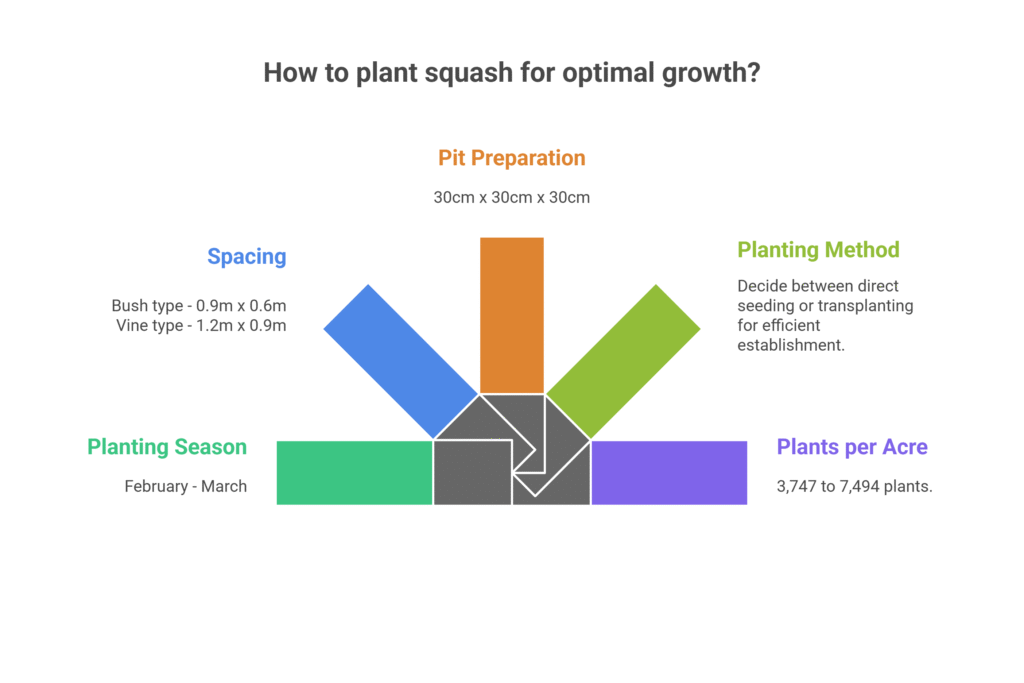
d). Planting Method
Squash can be planted either by direct seeding or transplanting. In direct seeding, 2–3 seeds are sown per pit at a depth of 2–3 cm, and after germination, seedlings are thinned to leave the strongest one or two per pit. For transplanting, seedlings are carefully removed from trays and placed in the center of prepared pits, followed by immediate watering to ensure proper establishment.
e). Number of Plants per Acre
Based on the above spacing, an acre (4046 sq. m) can accommodate approximately 3,747 to 7,494 plants.
Intercropping
Squash can be intercropped with short-duration crops such as radish, lettuce, spinach, or coriander during its early growth stage, but it is advisable to avoid planting it alongside other cucurbits to reduce the risk of pest and disease transmission.
Irrigation
Immediately after planting or transplanting, light irrigation is essential to support seedling establishment. Flowering and fruit development are critical stages, as moisture stress during these periods can lead to flower and fruit drop. Drip irrigation is highly recommended because it conserves water, delivers moisture directly to the root zone, and keeps foliage dry, thereby reducing disease incidence. The irrigation schedule should be every 3–4 days during summer and every 7–10 days in cooler seasons, taking care to avoid overwatering.
Fertilizer and Manure
Soil testing provides the most accurate guidance for fertilizer application, but a general recommendation per acre can be followed to ensure balanced nutrient supply for optimal squash growth.
| Application Type & Timing | Details & Dosage | Time of Application |
| Basal Dose | • FYM/Compost: 15-20 tons per acre • Biofertilizer Mix: Azospirillum + PSB (Phosphate Solubilizing Bacteria) + Potash Mobilizing Bacteria – 800 grams of each per acre. • Chemical Fertilizers (NPK): 40-50 kg Nitrogen (N) + 50-60 kg Phosphorus (P₂O₅) + 40-50 kg Potash (K₂O) per acre. | Apply compost and biofertilizer during final plough and inorganic fertilizer during planting. |
| Top Dressing (Split applications during growth) | • Material: The remaining 40-50 kg of Nitrogen (N). • Apply in 2-3 split doses at the following stages: | 1. At the time of vining 2. At flowering 3. After the first harvest |
Weed Control
Weeds can compete aggressively with squash for nutrients and water, particularly during the early growth stages. Effective weed control includes cultural practices such as shallow hoeing and hand weeding, as well as mulching with black plastic or organic materials like straw, which suppress weeds, conserve soil moisture, and keep fruits clean. Chemical control is also an option, with pre-emergence herbicides like Pendimethalin applied after sowing or transplanting but before weed emergence, ensuring careful use according to label instructions.
Inter Culture Operation
For vining squash varieties, training plants onto trellises or A-frames helps save space, improves air circulation, exposes fruits to sunlight, and produces straighter, cleaner fruits with fewer rot problems. Pruning is generally not necessary for bush types, but for vining types, removing some lateral vines can help manage plant size and direct the plant’s energy toward fruit production.
Flowering and Fruit Management
A peculiar blooming structure found in squash plants is called monoecious, in which the same plant produces both male and female flowers. The male flowers must transport pollen to the female flowers’ receptive stigma in order for fruit production to be successful. For a productive harvest, bees and other pollinating insects are essential in the garden because they play a key role in this important process, known as pollination.
A lack of mature fruit development, known as poor fruit set, can be attributed to several factors. These typically include an absence of pollinating insects, stretches of excessively hot weather, or extended rain that disrupts pollinator activity. To combat this issue, gardeners can employ hand pollination. This technique, which involves the manual transfer of pollen from a male flower to a female flower using a soft brush or by carefully rubbing the blooms together, is highly effective for boosting production. It is particularly beneficial during unfavorable conditions or within protected environments like greenhouses.
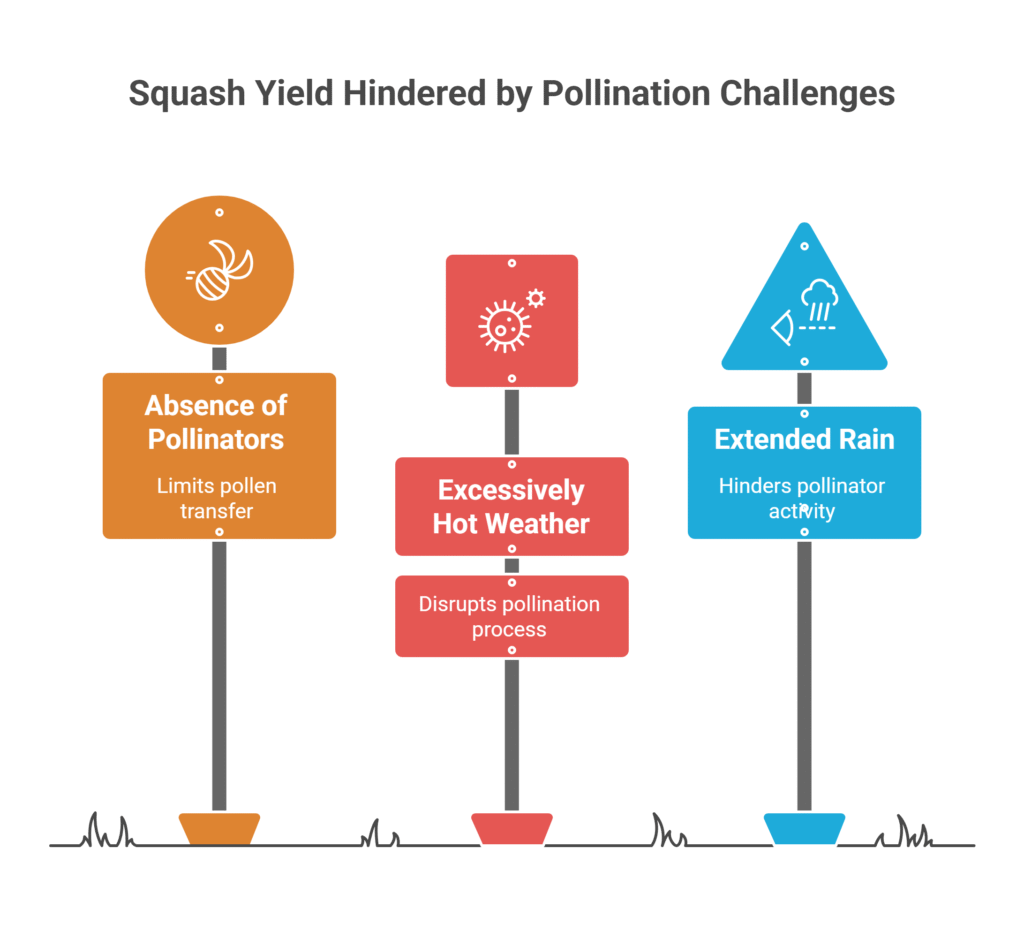
To ensure the remaining fruits develop to their full potential, a practice known as fruit thinning is recommended. This involves selectively removing fruits that are misshapen, diseased, or simply excessive in number. By reducing the competition for the plant’s energy and nutrients, this management strategy directs resources to the healthiest fruits, resulting in a harvest of larger, higher-quality squash.
Pest and Disease Management
Common Pests
Fruit Fly Management
Fruit flies are a significant pest whose larvae cause internal damage, leading to fruit rot and premature drop. An effective management strategy employs an Integrated Pest Management (IPM) approach. To monitor and trap adult flies, use 8-10 pheromone traps per acre, placed just above the crop canopy. Physically protecting the fruit by bagging them is a highly effective preventive method. For chemical intervention, apply neem-based insecticides such as neem oil at a concentration of 2-3 ml per liter of water, thoroughly coating the fruits and foliage. Repeat applications every 10-15 days, as needed.
Aphid and Whitefly Management
Aphids and whiteflies are sap-sucking insects that weaken the plant and are primary vectors for transmitting dangerous viral diseases. Monitoring is key; place 12-15 yellow sticky traps per acre to capture winged adults. Encourage biological control by introducing or conserving natural predators like ladybugs and lacewings. For direct control, insecticidal soap is a safe and effective option. Apply a solution with a concentration of 2.5-5 ml per liter of water, ensuring complete coverage of the undersides of leaves where these pests congregate. Reapply every 7-10 days following rain or if infestation persists.
Squash Vine Borer Management
The squash vine borer is a destructive pest whose larvae bore into and feed on the inside of plant stems, causing sudden wilting and plant death. Preventive cultural control, such as practicing a 3-4 year crop rotation with non-host plants, is highly recommended. For active infestation, a biological control method is effective. Inject the stems with the beneficial nematode Steinernema carpocapsae. The standard application rate is approximately 50,000 infective juveniles per plant, mixed in water according to the product label. This should be done at the first signs of borer activity (e.g., frass at the base of the stem) for best results.
Common Diseases
Powdery Mildew Management
The distinctive white, powdery growth that develops on the surfaces of leaves and stems clearly identifies powdery mildew as a fungal disease. The first steps in effective management include cultural techniques including choosing resistant cultivars, making sure plants are spaced sufficiently apart to allow for airflow, and watering the base of the plant to keep the foliage dry. Apply 3-5 grams of wettable sulfur per liter of water or 4-6 grams of fungicides based on potassium bicarbonate per liter for chemical control. Make sure all leaf surfaces are well covered by starting treatments as soon as disease symptoms appear and repeating every 7–14 days.
Downy Mildew Management
Downy mildew presents as angular, yellow spots on the upper leaf surface, often with a purplish, fuzzy growth on the underside during humid conditions. This disease spreads rapidly in cool, wet weather. The most effective strategy is preventative application of fungicides before disease onset, especially in conducive weather. Apply copper-based fungicides such as copper oxychloride at a concentration of 2-3 grams per liter of water. Coat the leaves thoroughly, including the undersides, and reapply every 7-10 days if wet conditions persist.
Damping Off Management
Seedlings that suffer from damping off, a soil-borne fungal disease, collapse and die soon before or after emergence. The only effective control is prevention because there is no cure once symptoms start to show. Use only approved, fungicide-treated seeds. Avoid overwatering, which produces the moist conditions that encourage the disease, and sow them in a sterile, well-draining potting mix. Avoiding seedling overpopulation and making sure there is adequate ventilation are also essential cultural practices to avoid this prevalent issue.
Bacterial Wilt Management
A bacterium that clogs the plant’s vascular system causes bacterial wilt, a deadly disease that causes quick and irreversible withering. The cucumber beetle is the main vector, dispersing the germs while it feeds. Once a plant is afflicted, there are no effective chemical therapies for the disease itself. Therefore, management must concentrate solely on reducing the number of cucumber beetles by using physical barriers such as row coverings to stop feeding and insecticides licensed for beetle control. To prevent future spread, diseased plants must be removed and destroyed right away.
Harvesting
Harvest summer squash frequently every two to three days to encourage continuous production. Harvesting should occur when the fruits are immature, sensitive, and the peel can be readily punctured with a thumbnail, usually 50 to 60 days after planting. Typically, winter squash is harvested 80–120 days after planting, when it is fully ripe, with a hard rind that is impossible to pierce with a fingernail and a stem that starts to dry and crack. Fruits should be carefully cut from the vine in both situations with pruning shears or a sharp knife, leaving a 3–5 cm stem attached to reduce bruising.
Yield
| Squash Type | Average Yield per Acre (kg) | Notes |
| Summer Squash | 8,000–12,000 | Yield varies with cultivar, season, and management practices. |
| Winter Squash | 10,000–15,000 | Yield varies with cultivar, season, and management practices. |
| Hybrids under Excellent Management | Higher than above | Drip irrigation and trellising can further increase yield. |
Cost of Investment per Acre for Squash Farming
| S.N. | Categories | Cost for Investment (NRs.) |
| 1 | Land Preparation | 15,000 |
| 2 | Seed | 2,000 |
| 3 | Nursery management | 3,000 |
| 4 | Transplanting | 5,000 |
| 5 | Fertilizers and Manure | 9,000 |
| 6 | Irrigation | 5,000 |
| 7 | Weed Control (pre & post-emergence) | 3,000 |
| 8 | Pest & Disease Control | 3,000 |
| 9 | Harvesting | 6,000 |
| 10 | Miscellaneous Costs | 5,000 |
| Total Investment Cost | 56,000 |
Income per Acre from Squash Farming
| Particulars | Estimated Yield (Kg) | Market Price (NRs./kg) | Total Income (NRs.) |
| Yield | 11,000 | 25 | 275,000 |
| Total Income | 275,000 |
Analysis of Squash Farming Profit Per Acre
| Metric | Value (NRs.) | Percentage/Ratio |
| Total Investment | 56,000 | – |
| Total Income | 275,000 | – |
| Net Profit | 219,000 | – |
| Return on Investment | – | ~391% |
| Benefit-Cost Ratio | – | ~4.91 |
If interested, please click: Brussels Sprout Farming Profit Per Acre
: Kohlrabi Farming Profit Per Acre
Squash Farming Crop Calendar
This calendar is based on the two primary planting seasons (Spring and Monsoon) and the single season in the hilly regions. Adjustments may be needed based on your specific local climate and weather patterns.
Phase 1: Pre-Planting (30-45 Days Before Sowing/Transplanting)
| Activity | Timing (Before Planting) | Key Tasks & Recommendations |
| Land Selection & Soil Test | 30-45 days | Select well-drained sandy loam or loamy soil. Conduct a soil test to determine precise fertilizer needs. |
| Land Preparation | 15-30 days | 1st Plowing: Deep plow (30-40 cm). Weathering: Leave soil for ~1 week. 2nd-3rd Plowing: 2-3 cross harrowings to achieve fine tilth. Incorporate 15-20 tons of well-decomposed FYM/compost during final harrowing. |
| Bed & Pit Preparation | 7-14 days | Form raised beds or ridges and furrows. Prepare pits of 30x30x30 cm. Mix soil from pits with 5-10 kg FYM and 100-150g basal fertilizer (e.g., NPK 10:10:10). |
| Nursery Sowing | 21-28 days (for transplanting method) | Sow treated seeds in 98-cell pro-trays with sterile potting mix. Place in protected nursery (greenhouse/shade net). Seedlings will be ready for transplanting in 3-4 weeks (2-3 true leaves). |
Phase 2: Planting (Sowing/Transplanting Window)
| Region | Season | Sowing Time | Transplanting Time | Method & Spacing |
| Plains | Spring (Zaid) | Feb – Mar | Mar – Apr | Direct sowing: 2-3 seeds/pit, 2-3 cm deep. Spacing: Bush: 90×60 cm, Vining: 120×90 cm. Thin to 1-2 strong plants/pit. |
| Plains | Monsoon (Kharif) | Jun – Jul | Jul – Aug | Transplanting: Use 3-4 week old seedlings from nursery. |
| Hills | Spring/Summer | Mar – May | Apr – Jun | Irrigate immediately after sowing/transplanting. |
Phase 3: Vegetative Growth Stage (Weeks 1-6 After Planting)
| Activity | Timing (After Planting) | Key Tasks & Recommendations |
| Irrigation | Immediately after, then every 3-4 days (Summer) | Light irrigation after planting. Drip irrigation is highly recommended. Maintain consistent moisture. |
| Thinning | Week 1-2 (for direct sowing) | Thin to leave the strongest 1 or 2 seedlings per pit. |
| Weed Control | Week 1-2 | Apply pre-emergence herbicide (e.g., Pendimethalin) if using. Begin shallow hoeing and hand weeding. Apply organic mulch (straw) or plastic mulch. |
| Top Dressing (1) | Week 3-4 (At Vining) | Apply first split dose of Nitrogen (N) from the remaining 40-50 kg. |
| Pest Monitoring | Ongoing | Install yellow sticky traps (12-15/acre) for aphids/whiteflies. Monitor for squash vine borer activity (frass at base). |
Phase 4: Flowering & Fruit Development (Weeks 5-10+)
| Activity | Timing (After Planting) | Key Tasks & Recommendations |
| Irrigation | Critical Stage | Do not allow moisture stress. Water every 3-4 days via drip. Avoid wetting foliage to prevent diseases. |
| Top Dressing (2) | Week 5-6 (At Flowering) | Apply second split dose of Nitrogen (N). |
| Pollination | During Flowering | Ensure pollinator activity. Hand pollinate if necessary (using a brush) to improve fruit set, especially during rain or heat. |
| Pest/Disease Control | Ongoing | Fruit Fly: Hang pheromone traps (8-10/acre), consider fruit bagging. Powdery/Downy Mildew: Apply recommended fungicides (e.g., wettable sulfur, copper oxychloride) at first sign. Vine Borer: Inject stems with beneficial nematodes if detected. |
| Training (Vining Types) | Week 5-6 | Train vines onto trellises or A-frames to save space, improve air circulation, and produce cleaner fruit. |
| Top Dressing (3) | After First Harvest | Apply final split dose of Nitrogen (N) to support continued fruiting. |
Phase 5: Harvesting & Post-Harvest (Weeks 7-18+)
| Activity | Timing (After Planting) | Key Tasks & Recommendations |
| Harvesting (Summer Squash) | Week 7-8 onwards | Harvest every 2-3 days. Fruit should be immature, tender, and pierceable with a thumbnail. Use a sharp knife/shears, leaving 3-5 cm stem. |
| Harvesting (Winter Squash) | Week 12-18+ | Harvest once fully mature. Rind should be hard and not pierceable with a fingernail. Stem should be dry and corky. |
| Post-Harvest | After Harvest | Handle carefully to avoid bruising. Summer squash is for immediate market. Winter squash can be cured (in sun for 7-10 days) and stored in a cool, dry place. |
Sources
Food and Agriculture Organization (FAO)
University of California Agriculture & Natural Resources (UC ANR)
European Plant Protection Organization (EPPO)
Punjab Agricultural University (PAU)
Tamil Nadu Agriculture University (TNAU) – Agritech portal
Indian Council of Agricultural Research (ICAR)
Nepal Agricultural Research Council (NARC)
U.S. Department of Agriculture (USDA).
Ministry of Agriculture and Livestock Development (Nepal)
Disclaimer: This crop farming profits assume optimal conditions. Actual results may vary depending on climate, market prices, and farm management practices.

